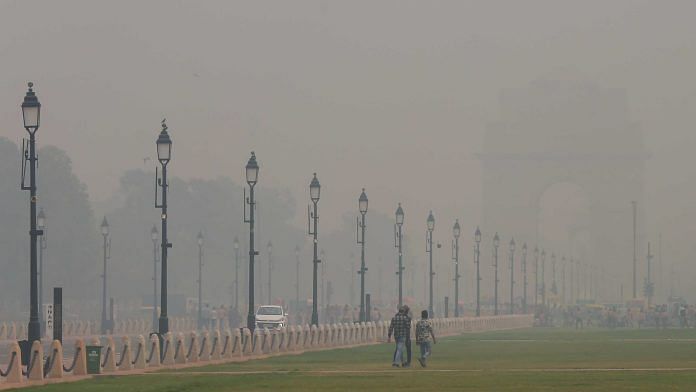If it wasn’t so deadly severe, we’d call it pollution tourism.
The media has had the unenviable task of taking us from an ‘air-mergency’ (India Today) through an ‘air-pocalypse’ (NDTV 24×7) and into the ‘gas chamber’ (Aaj Tak), which is the national capital after air pollution’s rise to such “severe” levels that “Residents struggling to breathe,” said CNN News 18.
The ‘Air We Breathe’ (Hindustan Times) is ‘unbreathable’ The Times of India said and this is leading to the ‘Murder of health’ (NDTV 24×7). Doctors tell the media that air pollution can reduce our life span by 12 years (NDTV 24×7) besides causing pulmonary and heart diseases. ‘City’s day 4 of severe air’, headlined TOI, ‘heading for a record 7?’
Meanwhile, The Indian Express reports that India has the highest rate of tuberculosis in the world—27 per cent of all cases—according to WHO.
Take a deep breath…or actually, don’t.
Aerial view of air
The city of Delhi is clothed in a grey film. TV reporters stand at the “iconic spot” to check out the visibility: “I am standing at India Gate and you can’t see Rashtrapati Bhavan from here,” lamented CNN News 18 correspondent as the TV camera lens—and his eyes—tried to penetrate the ‘smokescreen’ (Total TV) between him and the President of India’s official residence.
Aerial newspaper photographs captured the heavy haze hanging over Kartavya Marg (or Raj Path, once upon a history) that links the two landmarks of Delhi.
Cut to Punjab where the green, green farm land is dotted with burning fires and black cinders billow white smoke. Unmasked reporters and camerapersons, like the ones on Times Now, stand amidst these killing fields – they point to the stubble burning that has contributed so significantly to the air pollution in the national capital region (NCR). Drones deployed by channels like Zee News give us a bird’s eye view of smoking stubble that resembles funeral pyres from that height.
Also read: Israel, Mahua Moitra, Kerala, world cup—TV news covered everything but upcoming state polls
A rare united media
In this instance, the media is speaking for us, the people who live in NCR. “It’s difficult to continue to speak or breathe,” said Times Now anchor. “I can tell you each one of us reporting has (symptoms)… I have an aggravated cough…” said another anchor on India Today, while we watch on, sniffling, sneezing, or wheezing.
Print and broadcast media are on the same page and wavelength on this issue—and if the coverage is melodramatic or sensational, well, for once, we welcome it. Nothing is too much to force the authorities to act. So when APN News featured a doctor who told us we were being “forced to breathe smoke” the equivalent of three cigarettes a day, we should be scared.
TV news shows it like it is, newspapers tell it like it is. Together they are fighting for our ‘Right to Breathe’ (Times Now, CNN News 18). And what’s more, they’ve been doing this well before Delhi turned ‘sick’, as Zee News put it. The Indian Express series, ‘Death by Breath’, has warned against increasing air pollution in Mumbai as well, not just Delhi.
For the past few weeks, news channels have reported on the AQI levels rising in NCR. Delhi editions of newspapers have written reams on the projected AQIs, the rise and fall in farm fires (20,978 stubble burning instances until Wednesday, said TOI), health hazards—breast cancer among them, would you believe it—the farmers’ plight and whether the measures taken by the authorities help.
Not that they always agree: on Delhi government’s odd-even vehicle scheme, The Indian Express’ data indicated it helped ease pollution significantly with 12.5 lakh vehicles off the roads, while TOI cited studies that showed only ‘marginally less’ air toxicity.
The newspapers have explainers, opinion articles, editorials, and plenty of advice on wearing masks (N95 please), staying hydrated, and remaining indoors. If only…
News channels such as NDTV 24×7 have been in campaign mode: ‘AQI survival kit’ told us how to ‘live with bad air’ (basically, sit at home). News X did its homework and knowledgeably discussed ‘The Parali (stubble) Plan’. There were some really good ideas on how to convert stubble into useful commodities, data on baler quantities in Punjab, etc…
TOI revealed farm fires had increased in Rajasthan, Madhya Pradesh, and Uttar Pradesh, too, so beware folks. And HT said the NO2 levels from vehicles in Delhi was 2-3 times above permissible levels.
There’s so much information and so much speculation that it’s enough to give you insomnia.
Also read: Headlines say it all—NewsClick coverage shows a deeply divided Indian media
Hope ahead?
The politics of pollution: we can escape it just as much as we can the poor air quality. It is AAP v/s BJP each day on every channel. Delhi minister Gopal Rai blames Haryana and UP, while BJP’s Shehzaad Poonawala blames everything on the capital’s ruling party. On Aaj Tak, a frustrated anchor says that all parties and governments agree to work together “so why aren’t they meeting?” he asked.
The media has come in for some flak too. Rai said the media unfairly blamed the AAP government for inaction, and NDTV 24×7 anchor Vishnu Som said what we all know: the news cycle will soon move on and “nothing happens”.
But there may be some good news ahead: according to newspapers like the TOI and Express, the wind speed around NCR is likely to increase from 11 November to 15 kmph—there might even be a drizzle – and this will help reduce air pollution.
Let’s hope it will be a truly happier Diwali.
Views are personal.
(Edited by Prashant)



